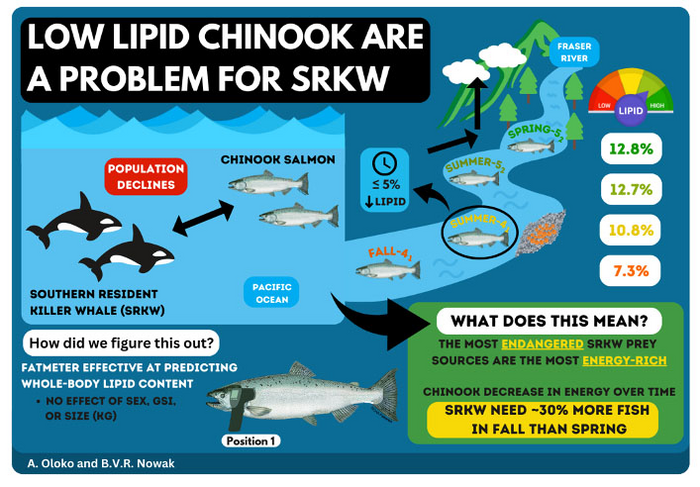Not all Chinook salmon are created equal, and this has a major impact on the energetics for southern resident killer whales. A recent study quantified the lipid content in Fraser River Chinook salmon – the southern resident’s preferred meal – and found that spring-run Chinook salmon, the earliest to arrive to the Salish Sea are lipid-rich and energy dense; a critical factor for the killer whales who prey on them. Fraser River Chinook salmon that come later in the season have lower energy density.

Credit: Infographic © Ayodele Oloko and Benia Nowak
Not all Chinook salmon are created equal, and this has a major impact on the energetics for southern resident killer whales. A recent study quantified the lipid content in Fraser River Chinook salmon – the southern resident’s preferred meal – and found that spring-run Chinook salmon, the earliest to arrive to the Salish Sea are lipid-rich and energy dense; a critical factor for the killer whales who prey on them. Fraser River Chinook salmon that come later in the season have lower energy density.
“This research helps us quantify the energetic requirements of the southern residents,” said Jacob Lerner, lead author of the study and a doctoral student in the Pelagic Ecosystems Lab at the Institute for the Oceans and Fisheries. “For example, if the southern residents ate just low-lipid salmon, they would have to eat around 80,000 more Chinook salmon every year than if they just ate high-lipid salmon.”
Southern resident killer whales are an iconic species in British Columbia’s Salish Sea and down the northeastern Pacific coast. With black and white markings, these marine mammals can weigh up to 12,000 pounds and be up to 26 feet long. They are fierce, social creatures that live and hunt in family group pods. And, sadly, there are only 73 left in the world.
Critically endangered by a number of anthropogenic factors, including noise pollution and high levels of water contaminants, their decline is mostly based on the limited availability of their preferred prey – Chinook salmon. However, there are many distinct populations of Chinook salmon available throughout the year, some with stock-specific differences in energy density, and not all in decline.
“We began with an initial hypothesis that these salmon were all created equal, that they all have the same value to resident killer whales. And we quickly realized that this is not true at all,” said Lerner. “They all have different levels of lipid content.”
Quantifying that lipid content is important as it directly relates to the caloric value of a salmon, assigning its value as prey. Specific estimates of lipid content for Chinook populations with different distributions, or run-timings, could be used to inform trends in killer whale populations, properly time fisheries closures, or even decide which hatcheries to augment to increase high quality food availability for southern residents, Lerner said.
This is particularly important as southern resident killer whales are a migratory species and often spend their winter months elsewhere. When they return to the Salish Sea for the spring and summer, their arrival often coincides with the arrival of the spring-run Fraser River Chinook salmon.
“Southern resident killer whales used to come here earlier in the spring season when they could eat early migrating Chinook salmon,” said Brian Hunt, associate professor in the Institute for the Oceans and Fisheries. “Those early Chinook were very energy dense as they need to fuel their long freshwater migration back to their spawning grounds, but those stocks have been declining. With the whales coming later, they mainly have access to Chinook from the lower Fraser. These fish don’t migrate very far, and have lower energy density.”
As a major source of prey for southern residents, estimates of lipid content from Fraser bound Chinook salmon may be one of the keys to helping both threatened species. “We identified a spectrum of high, medium and low-lipid Chinook populations from the Fraser that can be used to better inform energetics models and manage both species,” Lerner stated, “We also identified life history parameters for the salmon to predict where on this spectrum they may fall.”
Though the study has quantified lipid content in Fraser River Chinook, and shown new light on its life history drivers, there is still little information on how ocean conditions influence this energy accumulation.
“We plan to keep monitoring Fraser Chinook salmon fat content,” said Hunt. “And one of questions we want to answer is how changing ocean conditions might be affecting their energy accumulation. Our concern is that ocean warming and food web shifts in the North Pacific Ocean are leading to lower energy accumulation in Chinook salmon. This will have implications for both the Chinook themselves – will they have enough energy for return migration and spawning? – and the killers whales that depend on them.”
‘Seasonal variation in the lipid content of Fraser River Chinook Salmon (Oncorhynchus tshawytscha) and its implications for Southern Resident Killer Whale (Orcinus orca) prey quality‘ was published in Scientific Reports.
Journal
Scientific Reports
DOI
10.1038/s41598-023-28321-9
Method of Research
Meta-analysis
Subject of Research
Animals
Article Title
Seasonal variation in the lipid content of Fraser River Chinook Salmon (Oncorhynchus tshawytscha) and its implications for Southern Resident Killer Whale (Orcinus orca) prey quality
COI Statement
The authors declare no competing interests.




